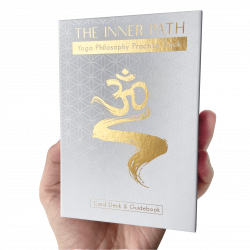
Definition: Guna appears in many ancient and medieval era Indian texts. In Samkyha philosophy it means quality, peculiarity, tendency, attribute, property, species
Card Symbology:
The black triangle is filled with tar, representing the denseness and inertia of tamas, as well as the stickiness in which things become trapped. The blue triangle represents sattva, symbolizing space, lightness and clarity as the harmonizing element in the center among the gunas. The red triangle represents rajas with the element of fire. The burst on one side shows that rajas can be explosive if uncontained.
“Freedom is a non-clinging state – allowing life to become something else, continuously.”
— Wisdom Master Maticintin
2.18 prakasha kriya sthiti shilam bhuta indriya atmakam bhoga apavarga artham drishyam
The seen is of the nature of the gunas: illumination, activity and inertia; and consists of the elements and sense organs, whose purpose is to provide both experiences and liberation to the Purusha. — Patanjali
Exploration:
Prakriti is the pure potential, the substrate of nature, out of which all forms of Life arise. Modern science has now proven that everything in existence is energy – from physical matter, to the mind and even consciousness itself. Through deep existential inquiry, yogis discovered three modes of nature called the gunas – the fundamental trinity of prakriti that make up the rest of creation.
Sattva is the quality of awareness, purity, lightness and intelligence. Rajas is the quality of energy, action, change and movement. Tamas is the quality of decay, inertia and materiality . They are to nature what the three primary colours for a painter – from their palette nature produces endless variations of matter, life-forms and psychological states.
Each guna has a different rhythmic quality and energetic vibration. Our lived experience and capacity for manifesting what we want in life is strongly influenced by how we embody these qualities.
If you receive this card, it’s an invitation to look at which behaviours that support your well-being versus those that don’t. Sattva keeps the mind light, restful, and able to sustain focus for long periods of time. Insight is spontaneous and spiritual discernment develops. A sattvic diet of whole foods, spiritual associations and natural environments tend to have a calming effect on the mind and body, inclining us towards spiritual practice and harmonious relationships. The rhythm of sattva helps us to achieve great things with joy and balance while evolving those around us in the process.
How can you bring more sattva into your life as you balance the effects of the other gunas? Rather than viewing these changes as pros and cons, take stock of the life you want to live: what are the images, physical states, and emotions that feel expansive and uplifting? Pay attention as you align your choices with your inner compass and take the reigns of conscious evolution into your hands.
Just poses are not enough, discover a yoga approach that transforms yourself and your students. Integrate body, mind and spirit through mantra, asana, philosophy, meditation, raga music and breath.
Carry the wisdom of yogic science wherever you go with this yoga oracle and practice deck : featuring 26 art cards and wisdom guidebook.




